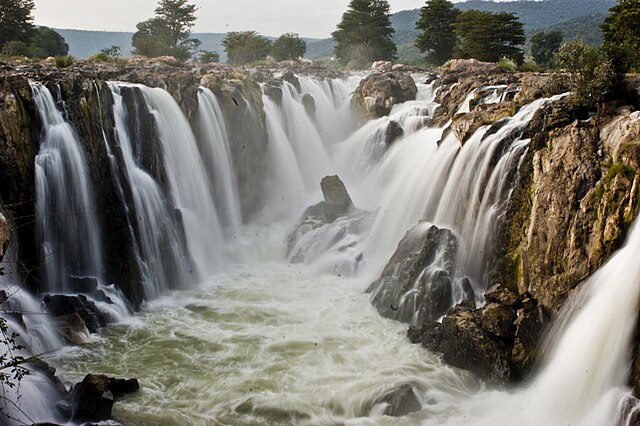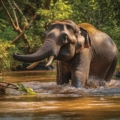Hidden amidst the lush landscapes of Tamil Nadu, India, lies the enchanting destination of Hogenakkal. This picturesque town, renowned as the “Niagara of India,” boasts a spectacular array of natural wonders that allure tourists seeking serenity and breathtaking beauty.
Hogenakkal Falls

The crown jewel of Hogenakkal is its majestic waterfall, a cascade of pristine water flowing from the Kaveri River. The name “Hogenakkal” translates to “smoking rocks,” an apt description of the mist that rises as the water forcefully descends over rocky terrain. Visitors can take coracle rides, traditional round boats steered by local boatmen, to get up close to the falls, feeling the thundering rush of water and witnessing rainbows forming in the mist.
Boating and Surrounding Scenery
The Kaveri River offers more than just the awe-inspiring falls. Tourists can revel in serene boat rides along the river, relishing the tranquil beauty of the surrounding cliffs, lush forests, and fascinating rock formations. The verdant greenery and the soothing sound of gushing water create an ambiance that’s both calming and invigorating.
Healing Baths and Wellness
Apart from its scenic beauty, Hogenakkal is renowned for its therapeutic baths. The medicinal properties of the water, enriched with herbs and believed to possess healing qualities, attract many seeking relief from various ailments. The locals offer massages using natural oils, adding to the holistic wellness experience.
Melagiri Hills and Cauvery Wildlife Sanctuary
The nearby Melagiri Hills and Cauvery Wildlife Sanctuary offer a different facet of Hogenakkal’s charm. Nature enthusiasts can embark on treks, encountering diverse flora and fauna along the way. The sanctuary is home to elephants, deer, and a myriad of bird species, making it a paradise for wildlife lovers and birdwatchers.
Local Culture and Cuisine
Immersing oneself in the local culture is an integral part of the Hogenakkal experience. Engage with the indigenous communities, known for their vibrant traditions and craftsmanship. Indulge in the local cuisine, savoring delicacies like fish curry, bamboo shoots, and millet-based dishes that tantalize the taste buds with their unique flavors.
Travel Tips
When planning a trip to Hogenakkal, consider visiting between October and March for pleasant weather conducive to exploration. While the monsoon season brings the falls to life in their full glory, it’s essential to check weather conditions and avoid heavy rains that might disrupt travel plans.
Conclusion
Hogenakkal, with its breathtaking waterfalls, serene river cruises, therapeutic baths, and natural beauty, offers a rejuvenating escape from the hustle and bustle of city life. It’s a destination that seamlessly blends adventure, relaxation, and cultural exploration, leaving an indelible mark on the hearts of those who venture into its embrace. Whether seeking adventure or seeking solace, Hogenakkal beckons with its unparalleled allure, promising an unforgettable sojourn amidst nature’s splendor.
Frequently Asked Questions (FAQs)
1. When is the best time to visit Hogenakkal?
The best time to visit Hogenakkal is between October and March. The weather during these months is pleasant, making it ideal for exploring the waterfalls and indulging in outdoor activities.
2. How can I reach Hogenakkal?
Hogenakkal is accessible by road from various cities in Tamil Nadu. The nearest major transportation hubs are Bangalore and Salem. Visitors can hire private vehicles or take buses from these cities to reach Hogenakkal.
3. What are the activities to do?
Hogenakkal offers a range of activities such as coracle rides to the waterfalls, boat cruises along the Kaveri River, indulging in therapeutic baths, exploring the nearby Melagiri Hills and Cauvery Wildlife Sanctuary, and experiencing the local culture and cuisine.
4. Are coracle rides safe at Hogenakkal Falls?
Yes, coracle rides are a popular and safe activity at Hogenakkal Falls. Local guides and boatmen are experienced in navigating the waters, ensuring a secure and enjoyable experience for tourists.
5. Are there accommodations available in Hogenakkal?
Hogenakkal offers a variety of accommodations ranging from budget guesthouses to resorts. Visitors can find options for staying near the falls or in nearby towns like Dharmapuri.
6. What precautions should I take while visiting Hogenakkal?
It’s advisable to wear suitable footwear for walking on rocky terrain, carry sunscreen and hats for sun protection, and follow safety instructions provided by guides during activities like boat rides and treks.
7. Is swimming allowed at Hogenakkal Falls?
Swimming is generally not permitted at Hogenakkal Falls due to the strong currents and rocky surroundings. It’s essential to prioritize safety and adhere to guidelines provided by authorities and local guides.
8. Can I experience local cuisine ?
Absolutely! Hogenakkal offers a taste of authentic South Indian cuisine. Visitors can relish local specialties like fish curry, bamboo shoots, and traditional millet-based dishes at eateries and local stalls.
9. Are there any cultural experiences to explore ?
Yes, visitors can immerse themselves in the local culture by interacting with indigenous communities, witnessing traditional craftsmanship, and participating in cultural events and festivals if they coincide with their visit.
10. Are there any entry fees for visiting ?
There might be nominal entry fees for specific attractions or parking charges, but generally, entry to the falls and surrounding areas is free. It’s advisable to check for any updated entry fees beforehand.
11. Can I visit Hogenakkal with children or elderly family members?
Yes, Hogenakkal can be visited with family members of all ages. However, it’s essential to consider the physical activities involved, such as walking on uneven terrain and boat rides, and ensure everyone’s comfort and safety.
12. Are there any restrictions or guidelines for photography at Hogenakkal?
Photography is generally allowed at most locations in Hogenakkal. However, it’s courteous to seek permission before photographing locals or specific cultural events. Additionally, during boat rides or at the falls, secure your camera or phone to prevent


